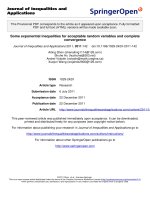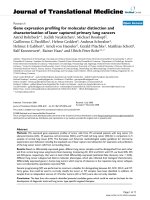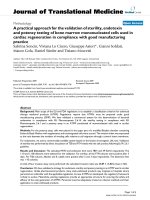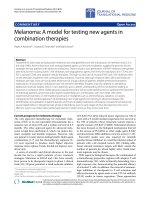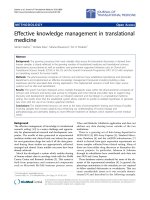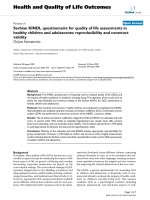Báo cáo hóa học: " BOB-RED queue management for IEEE 802.15.4 wireless sensor networks" pdf
Bạn đang xem bản rút gọn của tài liệu. Xem và tải ngay bản đầy đủ của tài liệu tại đây (1.26 MB, 16 trang )
RESEARCH Open Access
BOB-RED queue management for IEEE 802.15.4
wireless sensor networks
Mu-Sheng Lin
1*
, Jenq-Shiou Leu
1
, Wen-Chi Yu
1
, Min-Chieh Yu
1
and Jean-Lien C Wu
2
Abstract
Multimedia services over resource constrained wireless sensor networks (WSNs) face a performance bottleneck
issue from the gateway node to the sink node. Therefore, the queue management at the gateway node is crucial
for diversified messages conveyed from the front nodes to the sink node. In this article, beacon order-based
random early detection (BOB-RED) queue management is proposed. BOB-RED is a dynamic adaptation scheme
based on adjusting beacon interval and superframe duration in the IEEE 802.15.4 MAC superframe accompanied
with RED queue management scheme to increase the transmission efficiency of multimedia over WSNs. We focus
on the performance improvement upon different traffic loads over WSNs. Evaluation metrics include end-to-end
delay, packet delivery ratio, and energy consumption in IEEE 802.15.4 beacon enabled mode. Simulation results
show that BOB-RED can effectively decrease end-to-end delay and energy consumption compared to the DropTail
scheme.
Keywords: wireless sensor networks (WSNs), IEEE 802.15.4, superframe, beacon-enabled, beacon order (BO), super-
frame order (SO), queue management, DropTail, random early detection (RED)
1. Introduction
IEEE 802.15.4 standard [1] defines the protocol and
interconnection of devices via radio communication in a
wireless personal area network (WPAN). The standard
uses CSMA/CA medium access mechanism and sup-
ports star as well as peer-to-peer topologies. It provides
applications such as home entertainment and control,
security alarms, industrial monitoring a nd control, per-
sonal mobile healthcare and tele-assist, etc. Two types
of device called the full function device (FFD) and the
reduced function device (RFD) are used in a LR-WPAN
network. FFD is a fully functional device which can be a
PAN coordinator, a coordinator, or just a device. RFD is
a device with reduced functionality which can only func-
tion as an end device. It cannot communicate with any
other device in addition to coordinator. We talk about
the PAN-coordinator, which acts as a coordinator for
the entire WPAN. It is auth orized to provide synchroni-
zation services in an established network.
Little researches study transmission image or video
over IEEE 802.15.4 networks [2-6]. The CMUcam pro-
ject provides simple vision capabilities to small
embedded systems in the form of an intelligent sensor.
The CMUcam3 extends upon this idea by providing a
flexible and easy to use open source developmen t envir-
onment that complements a low cost hardware platform
[7]. It can be used for environment surveillance,
robotics, interactive toys, or object recognition and
tracking. Traffic loads on multimedia services over
resource constrained wireless sensor networks (WSNs)
sometimes are huge and bursty. Transmission of image
or video data requires careful handling to ensure that
end-to-end delay is within acceptable range. So, queue
managem ent algorithm on a gateway node should allow
temporary bursty traffic and prevent high delay. Up to
now, there are many popular queuing management algo-
rithms and packet scheduling mechanisms are proposed.
As popular known, various scheduling mechanisms such
as round-robin (RR), weighted ro und-robin (WRR), or
weighted fair queuing (WFQ) are different from queue
managements. Scheduling schemes focus on the
sequence and timing of packet transmission, and queue
management is obviously about managing queues in
* Correspondence:
1
Department of Electronic Engineering, National Taiwan University of Science
and Technology, Taipei, Taiwan, R.O.C
Full list of author information is available at the end of the article
Lin et al. EURASIP Journal on Wireless Communications and Networking 2011, 2011:107
/>© 2011 Lin et al; licensee Springer. This is an Open Access article distributed under the terms of the Creative Commons Attribution
License (http://cr eativeco mmons.org/licenses/by/2.0), which permits unrestricte d use, distribution, and reproduction in any medium,
provided the original work is pro perly cited.
forwarding devices such as router or relay node. Queue
managements can separate into passive queue manage-
ment (PQM) and active queue management (AQM).
DropTail can be classified as a PQM algorithm since it
is basically a simple first in first out (FIFO) mechanism
where packets are dropped when queue length exceed
buffer length. Random ear ly detection (RED) is the most
commonly used queue management algorithm in AQM
class [8,9]. Patel et al. [10] proposed comparison
between two queuing management system RED and
DropTail for avoiding the congestion in high speed
packet switched networks. Epiphaniou [11] focuses on
three different mechanisms, namely, DropTail (FIFO),
RED, and DiffS erv, and their effects on realtime voice
traffic. Flow RED is an extended version of RED. It
behaves just like RED, but maintains per-flow states f or
all flows in the gateway node. Using this per-flow state,
FRED preferentially dro ps the packets of flows that have
queue sizes larger than the average per-flow que ue size
[12]. Deficit Round Robin is a variant of WFQ disci-
pline. It allows WFQ to handle variable packet sizes in a
fair manner. It guarantees nearly perfect fairness for
flows that have at least one packet in the router buffer.
Longest queue drop is used as a packet drop strategy
[13]. Ali Ahammed and Banu analyze the performance
of AQM algorithms including FRED, BLUE, SFB, and
CHOKe. They aim at a thorough evaluation among
these algorithms and illustrations of the ir characteristics
by simulation [14]. Le et al. [ 15] evaluate t he perfor-
mance of their analytica l on M/M/1 queuing model for
IEEE 802.15.4 non-beacon-enabled mode at the 2.4 GHz
in NS-2 network simulator. Misic and Misic [16] analyze
the performance of a personal area network ope rating
under the IEEE Standard 802.15.4 in the beacon-enabled
mode, and derive the probability distribution of packet
access delay and calculate the throughput. Buratti [17]
proposed a mathematical model for the beacon-enabled
mode of IEEE 802.15.4. Gao and He [18] proposed an
individual beacon order adaptation (IBOA) algorithm
for IEEE 8 02.15.4 networks, which can individually
adapt the beacon interval (BI) and duty cycle of each
node at the same time to the node’s individual perfor-
mance requirements. Jeon et al. [19] proposed a new
duty-cycle adaptation algorithm for IEEE 802.15.4 bea-
con-enabled networks. They modify the reserved frame
control field in the MAC layer header to deliver the end
device’s buffer occupancy and queuing delay.
Despite m any researches study about the applications
of 802.15.4 on industrial and MAC protocol, but little
attention in the past has been given to how different
queuing management algorithms, such as DropTail and
RED, perform in terms of different settings of beacon
order (BO), superframe order (SO) parameters on the
multimedia service over IEEE 802.15.4 WSNs. As per
our literature search, only a few studies have so far ana-
lyzed the impact of BO, SO value on IEEE 802.15.4
operation. But, none article invested RED queue man-
agement accompanied with BO, SO value for IEEE
802.15.4 WSNs. Moreover, most current gateway nodes
use DropTail as a queue management scheme, which
does not guarantee fairness and delay bound. There has
been no motivation for realtime applications to use end-
to-end congestion avoida nce mechanisms for IEEE
802.15.4 WSNs. We study the performance evaluation
of different queue management algorithms, such as
DropTail, RED on gateway node in this article.
In this study, we focus on the performance improve-
ment upon different traffic loads over WSNs. Figure 1
shows a typical multimedia application over WSNs that
a front sensor node equipped with a camera sends an
emergent message containing the surveillance image to
thesinknodeonceitdetects an urgent or intrusive
event. Different traffic types demand different packet
delivery ratios and end-to-end delays. Urgent messages
always have a first priority with a minimum end-to-end
delay. On the other hand, keep-alive messages carrying
small periodic data have a comparatively low priority
which can tolerate a longer delay. Hence, a dynamic
adaptation scheme based on adjusting BI and super-
frame duration (SD) in the IEEE 802.1 5.4 MAC super-
frame is proposed to increase the transmission efficiency
of multimedia over WSNs.
This article presents beacon-order based RED (BOB-
RED) queue management for congestion a voidance in
IEEE 802.15.4 WSNs. The proposed s cheme consists of
a virtual threshold function, a dynamic adjusted per-
flow drop probability, a dynamic modification of BO
and SO strategy t hat decrease end-to-end delay, energy
consumption, and increase throughput when there are
different traffic type flows through the gateway node.
A comprehensive simulation for the proposed
scheme using the NS-2 network simulator is also pre-
sented in this study. Evaluation metrics include end-
to-end delay, packet delivery ratio, and energy
Figure 1 Multimedia service over IEEE 802.15.4 wireless sensor
networks.
Lin et al. EURASIP Journal on Wireless Communications and Networking 2011, 2011:107
/>Page 2 of 16
consumption using the beacon-enabled and non-bea-
con-enabled mode in IEEE 802.15.4 WSNs. Distinct
network topologies like star, tree, and chain architec-
tures comprising one coordinator and some stationary
nodes are considered in the simulation. Simulation
results show that a suitable queuing management
scheme accompanied with an appropriate setting of
BO, SO can effectively achieve a better performance. If
the BO value is fixed, a smaller SO value would incur
a higher end-to-end delay and a lower packet delivery
ratio. If the BO value is equal to the SO value, a larger
BO can achieve a higher packet delivery ratio and a
lower average end-to-end delay. Besides, the BOB-RED
queue management scheme can decrease end-to-end
delay compared to the DropTail scheme.
The remainder of the article is structured as follows:
in Section 2 we introduce IEEE 802.15.4 MAC super-
frame structure and the co ncepts of RED. In Section 3,
we describe the BOB-RED algorithm in detail. In Sec-
tion 4, we describe network configuration and assump-
tions. In Section 5, we present the results of our
simulations. Finally, in Section 6, we present our main
conclusions and suggest a number of areas for further
study.
2. IEEE 802.15.4 MAC superframe structure and
RED
2.1 IEEE 802.15.4 MAC superframe structure
IEEE 802.15.4 MAC protocol supports the beacon-
enabled and non-beacon-enabled modes. In beacon-
enabled mode, the access to the channel is managed
through a superframe, starting with the beacon packet
transmitted by the PAN coordinator. The superframe is
subdivided into a contentio n access period (CAP), con-
tention-free period (CFP), and an inactive part. Nodes in
CAP use a slott ed CSMA/CA to contention for channel
and CAP containing a number of GTSs that can be allo-
cated by the PAN c oordinator to specific nodes. In the
non-beacon-enabled mode, there are no regular beacons,
but the coordinator may unicast beacons to a soliciting
device. Communication among devices in the non-bea-
con-enabled mode uses unslotted CSMA/CA for decen-
tralized access. This article considers CAP and inactive
period only when the beacon-enabled mode is used. Fig-
ure 2 shows the IEEE 802.15.4 MAC superframe struc-
ture [20].
The structure of this superframe is described by the
values of macBeaconOrder (BO) and macSuperframeOr-
der (SO). The MAC PIB attribute macBeaconOrder
describes the interval at which the coordinator shall
transmit its beacon frames. The superframe order is the
variable which is used to determine the length of the SD
which is divided into 16 time slots. Similarly, the BI is
determined by the variable BO.
Since the time of the SD cannot exceed the time of a
BI, the condition for both parameters is 0 ≤ SO ≤ BO ≤
14. When BO is greater than SO, it indicates that there
is an inacti ve portion present in the s uperframe. Also
for SO = BO, the BI is same as the SD indicating there
is no inactive portion.
The values of macBeaconOrder, BO, and the BI are
related as follows:
BI = aBaseSuperframeDuration × 2
BO
SD = aBaseSuperframeDuration × 2
SO
• BaseSupe rframeDu ration = 960 symbols = 1 5.36
ms, each time slot has a duration of 15. 36/16 = 0. 96
ms.
• Non-beacon-enabled mode: BO = SO = 15. If BO
= 15, the coordinator will not transmit beacon
frames except when requested to do so, such as on
receipt of a beacon request command. T he value of
macSuperframeOrder shall be ignored if BO = 15.
Three topologies are proposed in IEEE 802.15.4 proto-
col standard. In a star topology, data transmission can
from a device to the coordinator or from the coordina-
tor to the device (Figure 3) [1].
Figure 2 IEEE 802.15.4 MAC superframe structure.
Figure 3 Data transmission from device to coordinator.
Lin et al. EURASIP Journal on Wireless Communications and Networking 2011, 2011:107
/>Page 3 of 16
Following shows part of NS2 trace file i n the beacon-
enabled mode (BO = SO = 3). Node 0 is the coordinator
and node 1 is an FFD that sends constant bit rate (CBR)
traffictonode0.WesetthevaluesofBO,SOequalto
3 so the value of BI is 15.36 ms × 2
3
= 122.88 ms. From
trace file, we can observe node 0 sends BCN (beacon)
every 122.88 ms (1.775232000 - 1.652352000).
s 1.652352000_0_MAC–0 BCN 12 [0 ffffffff 0 0]
s 1.775232000_0_MAC–0 BCN 12 [0 ffffffff 0 0]
s 1.789120000_1_MAC–0 CM1 17 [0 0 1 0]
r 1.789856033_0_MAC–0 CM1 17 [0 0 1 0]
s 1.790272000_0_MAC–0ACK5[0100]
r 1.790624033_1_MAC–0ACK5[0100]
s 1.898112000_0_MAC–0 BCN 20 [0 ffffffff 0 0]
In the tree topology, data transmission can from a
device to the coordinator or from the coordinator to the
device. Following shows node 1 sends an association
request (CM1) to node 0.
s 1.789120000_1_MAC–0 CM1 17 [0 0 1 0]
r 1.789856033_0_MAC–0 CM1 17 [0 0 1 0]
s 1.790272000_0_MAC–0ACK5[0100]
r 1.790624033_1_MAC–0ACK5[0100]
s 2.282144033_1_MAC–0 CM4 16 [0 0 1 0]
r 2.282848067_0_MAC–0 CM4 16 [0 0 1 0]
s 2.283072000_0_MAC–0ACK5[0100]
r 2.283424033_1_MAC–0ACK5[0100]
s 2.283712000_0_MAC–0 CM2 25 [0 1 0 0]
r 2.284704033_1_MAC–0 CM2 25 [0 1 0 0]
s 2.284896033_1_MAC–0ACK5[0010]
r 2.285248067 _0_ MAC–0ACK5[0010]
After that node 0 receives the request and sends back
an ACK. Connection is established. Then node 1 sends
a data request (CM4) a nd node 0 sends an ACK. Node
0 sends an association response (CM2) and node 1
sends back an ACK [1] (Figure 4).
2.2 Random early detection
RED, also known as random early discard or random
early drop, is an AQM algorithm. The operation of RED
queue management is shown in Figure 5.
When packets income, it calculates their current-
occupied average queue length (Avr).
It estimates the average queue size as follows.
Avr = (1 − w
q
) × Avr + w
q
×
q
where q is the instantaneous queue size, w
q
is the time
constant of the low pass filter.
(2) If the Avr is smaller than MinThr eshold (Min-
Thres), the packet will be kept and sent to the queue
waiting for the transmission.
(3)IftheAvrislongerthanMaxThreshold
(MaxThres), all packets will be dropped.
Figure 4 Data transmission from coordinator to device.
Figure 5 The operation of RED [8].
Lin et al. EURASIP Journal on Wireless Communications and Networking 2011, 2011:107
/>Page 4 of 16
(4) If the Avr is between MinThres and MaxThres, the
initial packet drop probability (P
b
)ofthepacketwillbe
a linear function of a number between 0 and Max
P
(default value of max. packet drop probability).
P
b
=Max
P
×
(
Avr − MinThres
)
/
(
MaxThres − MinThres
)
The actual probability (P
a
)isafunctionoftheP
b
and
count of the number of packets enqueued since the last
packet was dropped. P
a
=P
b
/(1 - count × P
b
)
Figure 6 shows the drop probability of RED. RED’s
performance is highly dependent on the settings of its
control parameters. We choose se veral control para-
meters offered by N S2, which includes qlen, Max
P
,
Min
th
,Max
th
and q_w that users may according the
requirements to adjust RED’s performance. However,
the impact of the individual parameter on the queue’s
performance is dependent on the others too. A set of
parameters are listed as below.
1. qlen: queue length.
2. Max
th
: maximum threshold for queue, Max
th
=
qlen /2.
3. Min
th
: minimum threshold for queue, Min
th
=
Max
th
/3.
4. Max
P
: maximum value for P
b
, Max
P
=2*packe-
t_loss_rate. NS-2 default value is 0.1.
5. q_w: queue weight, NS-2 default value is 0.002.
RED is the simplest queue management and compre-
hensivelyusedinmostrouters. Despite RED algorithm
is designed to accompany a tran sport-layer congestion
control protocol such as TCP in IP Networks. We try to
apply RED mechanism in IEEE 802.15.4 WSNs.
3. BOB-RED algorithm
3.1 Description of BOB-RED
Figure 7 shows the network topology with real-time
traffic and non-real-time traffic in multihop IEEE
802.15. 4 WSNs. Gateway node collects all the data from
relay nodes and sends them to sink. Taking the IBOA
[18] and DCA [19] for references, the BOB-RED adapts
BO, SO of each gateway node individually to meet the
needs of each gateway node working in a WSN. Unlike
a unique BO, SO applied to all of the nodes, the BOB-
RED assigns BO
i
,SO
i
for each neighbor node(i)(i Î [1,
N], N is the number of nodes working in the network)
which nearby the coordinator.
BOB-RED algorithm can also be applied to large num-
ber of sensor nodes because it only runs on coordinator
or gateway nodes. Multiple gateway nodes forward pack-
ets from end devices hop-by-ho p to coordinator. Even
though in a large-scale sensor networks, only a few relay
nodes which around the coordinator or gateway nodes
can transfer data directly to them. Owing to the gateway
nodes must be FFDs in IEEE 802.15.4 WSNs, every gate-
way node can dynamic adapt the BO, SO values. If we
apply BOB-RED algorithm to all gateway nodes, we
must consider whether gateway nodes can communicate
with the coordinato r. Rapidly or continually adapt their
BO, SO values may incur the link broken. In addition,
large hop counts will increase large loss rate in our
simulation. For simplify the complexity, only one gate-
way node is implemented in all our simulations.
The flowchart of BOB-RED algorithm is shown in Fig-
ures 8 and 9.
The operation of BOB-RED algorithm is very similar
to RED queue management. Figure 10 shows the state
transition diagram of BOB-RED. We describe the states
of a gateway node as follows:
State 0: The coordinator first sets the initially min_th,
max_th, max_p, q_w,BOandSOvalues.IfwesetBO
and SO values as 3, then the coordinator begins to
broadcast beacons. The gateway node calculates the
average queue length avg_q.
State 1: If the avg_q is smaller than min_th, then BO
and SO values decrease 1. If the avg_q is between
min_th and k, the BOB-RED moves to State 2. If the
BO and SO values are less than or equal to the
BO
min
,SO
min
, the BOB-RED moves to State 3.
State 2: If the avg_q is between min_th and k, BO
and SO values increase 1. If the avg_q is less than
min_th,theBOB-REDmovestoState1.IftheBO
and SO values are greater than or equal to the
BO
max
,SO
max
, the BOB-RED moves to State 4.
State 3: In this state gateway node operates using
BO
min
,SO
min
values. If the avg_q is greater than
min_th, the BOB-RED moves to State 2.
State 4: If the avg_q is greater max_th, all of packets
will be dropped. If BO is still bigger than BO
min
, the
MAC decreases BO and SO values by 1, and adds
the u pdate information on BO and SO values to the
Figure 6 The drop probability of RED.
Lin et al. EURASIP Journal on Wireless Communications and Networking 2011, 2011:107
/>Page 5 of 16
next beacon. If BO, SO values has reached BO
max
,
SO
max
, the BOB-RED returns to State 1.
Figure 11 shows that the buffer size B is divided into
four regions by thresholds min_th,k,max_th,where
min_th, k, max_th <B. When packet arrives, the gateway
node computes the average queue length. When the
average queue length exceeds a preset threshold k,the
gateway drops or marks each arriving packet with a cer-
tain probability, where the exact probability is a function
of the average queue length. P
ij
is the dropping prob-
ability, where i and j denote the number of real-time
and non-real-time packets in the buffer, respectively.
The value of P
ij
can b e dynamically calculated based
on the number of rear-time and non-real-time packets
in the queue, i.e.,
Pij =
⎧
⎨
⎩
0
(i + j) − k +1
max th − k +1
(1)
where P
loss, rt
denotes the drop probability of real-time
packet and P
loss, nrt
denote s the drop probability of non-
real-time packet, respectively.
Drop probability of real-time packet lists as in Equa-
tion 2.
Ploss, rt =
⎧
⎪
⎪
⎪
⎪
⎨
⎪
⎪
⎪
⎪
⎩
0
0
B
i=0
λrt
λrt + λnrt
pi, B − i
1
avg
q < min th
min
th ≤ avg q < k
k ≤ avg
q < max th
max
th ≤ avg q ≤ B
(2)
Drop probability of non-real-time packet lists as in
Equation 3.
Ploss, nrt =
⎧
⎪
⎪
⎪
⎪
⎨
⎪
⎪
⎪
⎪
⎩
0
B
i=0
B−i
j=0
(1 − αi, j)λnrt
λrt + λnrt
pi, j
Pij
1
avg
q < min th
min
th ≤ avg q < k
k ≤ avg
q < max th
max
th ≤ avg q ≤ B
(3)
Table 1 lists the dropping strategy with real-time and
non-real-time traffics under different buffer occupancy.
Figure 7 Network topology with real-time traffic and non-real-time traffic in multihop WSNs.
Lin et al. EURASIP Journal on Wireless Communications and Networking 2011, 2011:107
/>Page 6 of 16
Following shows the pseudocode of BOB-RED algo-
rithm.
for each packet arrival (class
rt
)
calculate the average queue size avg_q
rt
if min_th ≦ avg_q
rt
<k
accepted with probability 1
else if k ≦ avg_q
rt
< max_th
calculate probability with probability
Ploss, rt =
B
i=0
λrt
λrt + λnrt
pi, B − i
mark the arriving packet
else if max_th ≦ avg_q
rt
drop the packet
for each packet arrival (class
nrt
)
calculate the average queue size avg_q
nrt
if min_th ≦ avg_q
nrt
<k
calculate probability with probability
Ploss, nrt =
B
i=0
B−i
j=0
(1 − αi , j)λnrt
λrt + λnrt
pi, j
mark the arriving packet
else if k ≦ avg_q
nrt
< max_th
calculate probability with probability
Pij =
(i + j) − k +1
B − k +1
mark the arriving packet
else if max_th ≦ avg_
nrt
drop the packet
3.2 Queuing model of BOB-RED
It is noted that, in Figure 11, we have both real-time
and non-real-time traffic coexistings in the network.
The queuing model is specifically designed in each gate-
way node.
We use Table 2 to summarize most of the notation
we will use in the formulation.
The waiting time W
rt
and W
nrt
of real-time and non-
real-time traffic at a gateway node i can be calculated
according to Little’s formula [21] as follows:
Wrt =
B
i=1
B−i
j=0
ipi, j
λrt(1 − Ploss, rt)
(4)
Wnrt =
B
i=0
B−i
j=1
jpi, j
λnrt(1 − Ploss, nrt)
(5)
where P
ij
is the steady-state probability, where i and j
denote the number of real-time and non-real-time pack-
ets in the buffer, respectively. The loss probabilities P
loss,
rt
and P
loss, nrt
of real-time and non-real-time packets at
a gateway node i are given as follows.
Ploss, rt =
B
i=0
λrt
λrt + λnrt
pi, B − i
(6)
Ploss, nrt =
B
i=0
B−i
j=0
(1 − αi , j)λnrt
λrt + λnrt
pi, j
(7)
Figure 8 BOB-RED algorithm.
Lin et al. EURASIP Journal on Wireless Communications and Networking 2011, 2011:107
/>Page 7 of 16
Since we ignore the propagation delay, th e end-to-end
queuing delay of real-time traffic for a particular path is
Tend − end =
∀i∈path
Q
i
rt
=
∀i∈path
1
u
i
rt
− λ
i
rt
=
∀i∈path
1
urt − siλ
rt
−
ri
j=1
sjλ
i
rt
(8)
Since the multimedia service is time-constrained. We
expect the end-to-end delay along a path under a
threshold value.
3.3 The relationship of BO, SO, traffic load against the
performance metrics
We use virtual queues for the two different types of traf-
fic, real-time traffic and non-real-time traffic, whose
packets are labeled as different flow number accordingly.
Ongatewaynode,thereisanagentwhichdetermines
the order of packets to be transmitted from the queues
according to the BOB-RED algorithm. It also checks the
type of the incoming packet and sends it to the appro-
priate queue according to average queue siz e avg_q, BO ,
SO, min_th, max_th, max_p parameters.
Table 3 concludes the relationship of BO, SO, traffic
load against the performance metrics of delay, through-
put and power consumption from many articles.
From many times of experiments, we find somewhat
relationship between qualities of services with all the
parameters.
We divide all the factors that affect end-to-end delay
into five levels from vary parameters. For example, BO,
SO values are from 0 to 15. If we set BO, SO value
from 0 to 2, the level in spiderchart is 0.
Figure 9 BOB-RED algorithm.
Lin et al. EURASIP Journal on Wireless Communications and Networking 2011, 2011:107
/>Page 8 of 16
Figure 10 State transition diagram of BOB-RED algorithm.
Figure 11 Queuing model of BOB-RED.
Lin et al. EURASIP Journal on Wireless Communications and Networking 2011, 2011:107
/>Page 9 of 16
Figure 12 shows the spiderchart of achieving QoS con-
strained in end-to-end delay. From Figure 12, BO and
SO obviously affect the end-to-end delay. Buffer size is
not helpful to decrease end-to-end delay. Threshold k is
helpful to increase throughputs.
4. Network configuration and assumptions
The solution performance evaluation is carried out
under the NS2 simulator [22]. We use the ns2 module
developed by Zheng and L ee for IEEE 802.15.4 (NS-
2.28) in our simulation. In all simulation, we have con-
sidered the followings.
1. The p hysical layer consists of IEEE 802.15.4 com-
pliant radio transmitter (tx) and receiver (rx) that
operate in t he ISM band at 2.4 GHz, with raw data
rate 250 kbps. The modulation technique is Qu adra-
ture Phase Shift Keying (QPSK).
2. The MAC sub-layer implements the slotted/
unslotted CSMA/CA.
3. The applica tion layer includes three CBR tra ffic
sources with different data rate and one sink in this
article.
4. Different scenarios may have different parameter
values setting.
5. Burst traffic is generated from the camera that
capturing event photo and sending it to sink imme-
diately. We dynamically adapt BO, SO value to
investigate the performance.
Performance metrics measured in this article are the
following.
4.1 Average end-to-end delay
Average end-to-end delay is one of the most important
metrics to emergent events. In WSNs, the end-to-end
delay is the total time delay to deliver a packet from
source to sink node. It is the sum of delays at all links
within the end-to-end path. The delay at an intermedi-
ate node usually includes the following components:
processing delay, queuing delay, transmission delay, pro-
pagation delay, and retransmission delay. We mainly
consider the average end-to-end delay for all source
traffic along a multihop path to sink node. By decreasing
the packet retransmission, we can decre ase the average
end-to-end delay.
4.2 Packet delivery ratio
Packet loss may o ccur at any stage of a network trans-
mis sion, mainly due to link failures, CSMA/CA channel
access mechanism, RED problems. We use packet deliv-
ery ratio (PDR) to denote the performance.
PDR = received packets/sent packets
4.3 Energy consumption
The coordinator consumes the energy when it transmits
beacon and ACK packet, receives data packet, and lis-
tens the channel. Where rxPower is power consumption
in receiving a packet, txPower is power consumption in
transmitting a packet, sleepPower is power consumption
in sleep state, and i dlePower is power consumption in
idle state. To measure the energy consumption in our
scenarios, we use the energy model in NS-2. For acceler-
ating the power consumption in our simulation, we
modify the default values of the NS2 default value [17].
We only measure the energy consumption on coordina-
tor node in beacon-enabled/non-beacon-enabled modes.
Table 1 BOB-RED dropping strategy
Packet type
Buffer occupancy Real-time traffic Non-real-time traffic
avg_q < min_th Accepted with probability 1 Accepted with probability 1
min_th ≦ avg_q < k Accepted with probability 1 Rejected with drop probability P
loss, nrt
k ≦ avg_q < max_th Rejected with drop probability P
loss, rt
Rejected with probability 1-P
ij
max_th ≦ avg_q ≦ B Rejected with probability 1 Rejected with probability 1
Table 2 Notation table
Notation meaning
B buffer size
min_th minimum threshold for queue
max_th maximum threshold for queue
K a preset threshold value to separate different dropping
strategy for real-time data and non-real-time data
l
rt
real-time data generation rate
l
nrt
non-real-time data generation rate
μ
rt
service rate for real-time data
μ
nrt
service rate for non-real-time data
Q
i
rt
queuing delay on a gateway node i for real-time traffic
s
i
the number of sensing neighbours of gateway node i on
path
r
i
the number of relaying neighbours of gateway node i on
path
P
loss, rt
loss probabilities of real-time packets
P
loss, nrt
loss probabilities of non-real-time packets
W
rt
waiting time of real-time traffic at a gateway node i
W
nrt
waiting time of non-real-time traffic at a gateway node i
T
end-end
end-to-end queuing delay for a particular path
Lin et al. EURASIP Journal on Wireless Communications and Networking 2011, 2011:107
/>Page 10 of 16
5. Performance eval uation
There are thre e scenarios in this study, namely, chain
topology, tree topology, and star topology. The simula-
tion parameters are summarized in Table 4. Simulation
duration is set to 60 s of which the first 5 s allow the
nodes to associate with the PAN coordinator, and the
remaining time is used for sending application traffic.
5.1 Chain topology
Figure 13 illustrates the network topology with two FFD
nodes (n1, n2) and one PAN coordinato r (node 0). Each
sensor node is set 20-m away from the other nodes.
Three CBR traffic flows (Cbr1, Cbr2, and Cbr 3) enter
node 1 and then be sent with the average data rate (2
packets/s) through the coordinator (nod e 0) to the sink
Table 3 The relationship of BO, SO, traffic load against the performance metrics
BO = SO BO (SO fixed) SO (BO fixed) Delay Throughput Power consumption
↑↑ ↑ ↑ ↑ ↑
Small Small Small Low Low Large
Large Large Large High High Small
↓↓ ↓ ↓ ↓ ↓
Traffic load (BO = SO) Delay Throughput Power consumption
↑↑↑↑
small Low High Small
Large High Low Large
↓↓↓↓
Figure 12 Spiderchart of QoS capability end-to-end delay constrained.
Lin et al. EURASIP Journal on Wireless Communications and Networking 2011, 2011:107
/>Page 11 of 16
node (node 2). Each node’s queue size is set to 50
packets.
5.2 Impact of different BO, SO for traffic loads (beacon-
enabled mode)
For each configura tion, we vary the inter-arrival time of
the flows in source node to have different offered loads,
assuming a constant packet size. With high offered
loads, it causes higher packet loss because of the queue
full. With low offered loads, it causes the increase in the
average end-to-end delay.
Table 5 shows the PDR and average end-to-end delay
(Avg. delay) using DropTail queue management scheme
when SO value is fixed to 0. The PDR values are all
zero when BO is greater than 5. Source node cannot
transmit data successfully due to long BI and inactive
period.
We run the simulation for different values of SO (and
BO = SO) as shown in Table 6. When BO equals to SO,
less SO value will result in average end-to-end delay
increased. When BO value is small, the probability of
collision is increased. The bottom of Table 6 shows
when BO is fixed, higher SO values have lower average
end-to-end delay because of inactive period d ecreased.
Sensor nodes do not change into sleep mode when BO
equals to SO.
5.3 Impact of traffic loads (non-beacon-enabled mode)
In this simulation, we send a CBR packet every 5 s for
keep-alive traffic, the trafficwithdatarate2packets/s
stands for normal traffic, a nd the traffic which sending
20 packets/s is defined as emergent multimedia traffic
load. We set BO, SO value to 15 to evaluate the
Table 4 Simulation parameters
NS-2 parameters
Simulation tool NS-2
Radio range 25 m
Data bit rate 250 Kbps
Routing protocol AODV
Scale 50 m × 50 m
Nodes 3, 4, 5 wireless static nodes
Simulation time 60 s
TX power 13.132 mW,
RX power 13.528 mW,
Idle power 712e-7 mW
Sleep power 144e-8 mW
Node’s initial energy 10 J
Mean packet size 50 bytes
Traffic type CBR
RED parameters
Minthresh 10
Maxthresh 30
k_th 20
q_weight 0.002
Gentle True
Mark_p 0.1
Packet_loss_rate 0.05
Figure 13 Chain topology.
Table 5 PDR and average delay (droptail, 2 pkts/s, SO =
0)
BO PDR (%) Avg. delay (s)
0 100 0.051798
2 100 0.273113
3 100 0.773140
4 1.67 12.413684
5 0 N/A
Lin et al. EURASIP Journal on Wireless Communications and Networking 2011, 2011:107
/>Page 12 of 16
performance in the non-beacon-enabled mode. Simula-
tion time is 60 s and queue size is 50 packets.
Table 7 shows that all metrics (packet delivery ratio,
end-to-end delay, and energy consumption) have not
any differences between DropTail and BOB-RED algo-
rithm. Due to unslotted CSMA/CA does not use beacon
to coordinate devices. Node which acquires the channel
can transmit data immediately, so the queue length
always is empty. BOB-RED mechanism does not work
in the non-beacon-enabled mode. The PDR value is
only 39.27% with 20 packets/s traffic load because of the
energy of node 0 runs out at 26.808665200 s.
5.4 Tree topology
In the second set of experiments, we study the effect of
dynamic adaptation scheme. Figure 14 illustrates the
network topology with four nodes defined using NS-2
(n0, n1, n2, n3). Each sensor node is set 20 m away
from the other nodes. We assume node 1, node 2 does
not aff ect each other. Simulation parameters are all the
same as shown in Table 4.
We ru n the simulation for different values of BO, SO
where BO equals to SO from 0 to 9 with burst traffic.
DropTail is the queue management scheme. Nod e 2
sends CBR traffic to node 0 with 2 packets/s from 10 to
55 seconds. Following node 1 sends burst traffic with
100 packets/s from 25 t o 45 s. All nodes are setting the
same BO = SO = 3 value in default simulation. Dynamic
adaptation scheme chan ges vary BO, SO values when
burst traffic load comes.
Table 8 shows the comparison of default BO, SO
value with dynamic adaptation scheme in the average
end-to-end delay, PDR, and energy consumption
Table 6 Impact of traffic loads (droptail)
BO SO 50 pkts/s Avg. delay (s) 100 pkts/s Avg. delay (s)
0 0 1.424160 1.430937
1 1 0.764768 0.781810
2 2 0.612112 0.621294
3 3 0.539826 0.570217
4 4 0.526245 0.552005
5 5 0.536100 0.559807
6 6 0.535082 0.542379
7 7 0.551991 0.518774
3 0 8.071928 8.064701
3 1 5.832748 5.825045
3 2 1.691801 1.690489
3 3 0.539826 0.570217
Figure 14 Tree topology.
Table 7 Droptail vs. BOB-RED with different traffic loads
DropTail BOB-RED
Traffic load (packets/s) PDR (%) Avg. delay (s) Energy PDR (%) Avg. delay (s) Energy
0.2 100 0.022207 9.712956 100 0.022207 9.712956
2 100 0.019916 7.442435 100 0.019916 7.442435
20 39.27 0.018763 0.005730 39.27 0.018763 0.005730
Table 8 Performance of dynamic adaptation scheme
BO =
SO
Avg. delay
(s)
PDR
(%)
Residual energy (node 0
lifetime)
0 0.431532 25.68 Runs out at 35.987584067 s
1 0.256503 26.16 Runs out at 35.430432000 s
2 0.426992 24.63 Runs out at 59.960032000 s
3 0.313196 25.97 Runs out at 33.130784000 s
4 0.615563 25.11 Runs out at 43.386624067 s
5 0.467911 20.66 1.557760 J
6 0.299833 25.78 3.655319 J
7 0.841543 14.97 3.289051 J
8 4.010992 14.16 3.008140 J
9 0.287230 14.16 3.552419 J
Figure 15 Star topology.
Lin et al. EURASIP Journal on Wireless Communications and Networking 2011, 2011:107
/>Page 13 of 16
metrics. The average end-to-end delay is 0.313196 s and
PDR is 0.2597 in default scheme. We observe that when
setting BO = SO = 6, PDR is similar with default
scheme but average end-to-end delay can effectively
decrease in dynamic adaptation scheme. When the
simulation ends, c oordinator node 0 still remains
3.655319 J power in dynamic adaptation scheme. Con-
versely, residual energy of coordinato r node 0 runs out
at 33.130784000 s in default scheme. Simulation result
shows suitably chooses BO, SO value can get longer life-
time and less average end to end delay than default set-
ting of BO, SO values.
5.5 Star topology
For investigating the effect of our scheme in multihop
environment, the modified star topology is used. We
design three traffic flows along coordinator to sink node
not only one hop to coordinator like standard. The
topology of this scenario is shown in Figure 15. Four
FFDs (nodes 1 to 4) are placed symmetrically around
the PAN coordinator (node 0) with an equal distance of
20 m. The traffics generated by nodes 1, 2, and 3 send
CBR traffics with 50 packets/s along coordinator (node
0) to sink node (node 4). Node 1 sends CBR traffic from
10 to 55 s. Node 2 sends CBR traffic from 25 to 40 s.
Node 3 sends CBR traffic from 40 to 55 s. The focus of
the experiment is the head of the bottleneck link
between n0, n4 and its buffer in particular. Node 0 is
the intermediate gateway node with DropTail or BOB-
RED queue implemented, with a buffer capacity of 50
packets and a queue fully monitored during the
simulation.
5.6 Simulation study in queue management scheme
A simi lar investigation has been conducted by changing
the actual queue mechanism to BOB-RED for all nodes.
Figure 16 Queue length of coordinator node, traffic load 50 packets/s.
Table 9 Droptail VS. BOB-RED with different traffic loads
DropTail BOB-RED
Traffic load PDR (%) Avg. delay (s) PDR (%) Avg. delay (s)
1 40 0.666688 40 0.666688
50 6.85 7.357023 6.59 3.115317
100 3.43 7.276406 3.29 3.027992
Lin et al. EURASIP Journal on Wireless Communications and Networking 2011, 2011:107
/>Page 14 of 16
BOB-RED operation is based on the principle that as the
probability of a packet being dropped increases, the pos-
sibility of this packet being enqueued decreases. Figure
16 shows the BOB-RED scheme has lower queue length
than DropTail. We observe queue length at the gateway
node 0 which is closest to the sink node and measuri ng
the end-to-end delay from source node to sink node. By
measuring the queue length of coordinator node (n0),
we can observe that queue occupy is not heavy. If the
traffic load is getting heavier, the amount of packets stay
in the queue will increase. BOB-RED can lessen the
congestion by early detecting the queue status to drop
packet to decrease the retransmission of arriving
packets.
5.7 Simulation study in PDR, average end-to-end delay
Simulation results show that light traffic load with BOB-
RED can get the same as DropTail in PDR and average
end-to-end delay. When traffic load is getting heavier,
despite the PDR is slightly lower than DropTail, but
BOB-RED can get lower average end-to-end delay than
DropTail. Table 9 shows the results.
5.8 Simulation study in energy consumption
Figure 17 shows the energy consumption with different
queue management scheme.
The traffic load is 100 packets/s; the total simulatio n
time is 60 s. When the traffic load is light (from 10 to
25 s), the energy consumption of DropTail is the same
as BOB-RED. Conversely, both two mechanisms
consume energy rapidly when traffic load i s getting hea-
vier (from 25 to 40 s). Then, we can observe that resi-
dual energy of coordinator node 0 is higher than
DropTail if using BOB-RED mechanism. This is because
BOB-RED can lessen traffic congestion to decrease the
energy consumption. As simulation result shows, using
BOB-RED can get better energy consumption than
DropTail when traffic load is getting heavier.
6. Conclusions
In this article, we evaluate several queue management
algorithms with respect to their abilities of maintaining
high resource utilization and low energy consumption in
IEEE 802.15.4 beacon-enabled and non-beacon-enabled
modes.
We compare the performance of BOB-RED and
DropTail on simulation results, using DropTail as the
evaluation base line. The characteristics o f different
algorithms are also discussed and compared. We evalu-
ate the impact of the following parameters on the per-
formance of slotted CSMA/CA: (1) the beacon order
and the superframe order, (2) queuing management
scheme such as RED and DropTail, (3) different traffic
loads with dynamic adaptation scheme. Simulation
results show that RED queue management scheme
accompanied with an appropriate setting of BO, SO
can effectively achieve a better performance. Besides,
the BOB-RED can decrease end-to-end delay and
energy consumption compared to the DropTail
scheme.
Figure 17 Comparing the energy consumption of BOB-RED with DropTail.
Lin et al. EURASIP Journal on Wireless Communications and Networking 2011, 2011:107
/>Page 15 of 16
Despite the vary kinds of experiments have done in
this article, how to correctly decide the BOB-RED para-
meters and BO, SO values accordin g different kind of
traffic loads is still an issue. In our future study, we will
observe mobile sink and sensor nodes as possible. How
the nodes mobility model and velocity to affect the end-
to-end delay, packet delivery ratio, and better energy
consumption in multimedia services over IEEE 802.15.4
wireless sensor networks is the direction of study.
Acknowledgements
The authors gratefully acknowledge the support by the National Science
Council, Taiwan, under grants 100-2221-E-011-154
Author details
1
Department of Electronic Engineering, National Taiwan University of Science
and Technology, Taipei, Taiwan, R.O.C
2
Department of Computer and
Communication Engineering, St. John’s University, Taipei, Taiwan, R.O.C
Competing interests
The authors declare that they have no competing interests.
Received: 30 March 2011 Accepted: 21 September 2011
Published: 21 September 2011
References
1. PART 15.4: Wireless Medium Access Control (MAC) and Physical Layer (PHY)
Specifications for Low-Rate Wireless Personal Area Networks (LR-WPANs).
IEEE Std. P802.15.4a/D5 (2006)
2. KY Wang, SS Lee, et al, Low-MAC FEC Controller for JPEG2000 Image
Transmission over IEEE 802.15.4, in WCSET 2009: World Congress on Science,
Engineering and Technology, 168–171 (February 2009)
3. KY Wang, SY Lee, et al, Robust JPEG2000 Image Transmission over IEEE
802.15.4, in IEEE International Symposium on Electronic Design, Test and
Application, 253–257 (2008).
4. A Zainaldin, I Lambadaris, B Nandy, Video over Wireless Zigbee Networks-
Multi-Channel Multi-Radio Approach, in Wireless Communications and Mobile
Computing Conference, 2008. IWCMC ‘08. International, 882–887
(August 2008)
5. S Hengstler, H Aghajan, WiSNAP, A Wireless Image Sensor Network
Application Platform, in TRIDENTCOM 2006 (March 2006)
6. G Pekhteryev, Z Sahinoglu, P Orlik, G Bhatti, Image Transmission over IEEE
802.15.4 and ZigBee Networks, in IEEE International Symposium on Circuits
and Systems (ISCAS). 4, 3539–3542 (May 2005)
7. CMUcam project, />8. Wikipedia, />9. S Floyd, V Jacobson, Random early detection gateways for congestion
avoidance. IEEE/ACM Trans Netw. 1(4), 397–413 (1993). doi:10.1109/
90.251892
10. S Patel, P Gupta, G Singh, Performance measure of Drop tail and RED
algorithm, in International Conference on Electronic Computer Technology
(ICECT),35–38 (2010)
11. G Epiphaniou, C Maple, P Sant, M Reeve, Affects of queuing mechanisms
on RTP traffic: comparative analysis of jitter, end-to-end delay and packet
loss, in ARES ‘10 International Conference on Availability, Reliability, and
Security,33–40 (2010)
12. D Lin, R Morris, Dynamics of random early detection, in Proceedings of ACM
SIGCOMM 97, Cannes, France, pp. 127–137 (1997)
13. M Shreedhar, G Varghese, Efficient fair queuing using deficit round-robin.
IEEE/ACM Trans Netw. 4, 375–385 (1996). doi:10.1109/90.502236
14. GF Ali Ahammed, R Banu, Analyzing the performance of active queue
management algorithms. Int J Comput Netw Commun. 2(2), 1–19 (2010)
15. NT Le, SW Choi, YM Jang, Approximate queuing analysis for IEEE 802.15.4
sensor network, in Second International Conference on Ubiquitous and Future
Networks (ICUFN), 193–198 (2010)
16. Jelena Mišić, Vojislav Mišić
B, Access delay for nodes with finite buffers in
IEEE 802.15.4 beacon enabled PAN with uplink transmissions. Comput
Commun J. 28(10), 1152–1166 (2005). doi:10.1016/j.comcom.2004.07.017
17. C Buratti, Performance analysis of IEEE 802.15.4 beacon-enabled mode. IEEE
Trans Veh Technol. 59, 2031–2045 (2010)
18. B Gao, C He, An individual beacon order adaptation algorithm for IEEE
802.15.4 networks, in Communication Systems, 2008. ICCS 2008. 11th IEEE
Singapore International Conference on,12–16 (November 2008)
19. J Jeon, JW Lee, JY Ha, WH Kwon, DCA: duty-cycle adaptation algorithm for
IEEE 802.15.4 beacon-enabled networks, in Vehicular Technology Conference,
VTC2007-Spring. IEEE 65
th
, pp. 110–113.
20. J Zheng, MJ Lee, Will IEEE 802.15.4 make ubiquitous networking a reality? A
discussion on a potential low power, low bit rate standard. IEEE Commun
Mag. 42(6), 140–146 (2004)
21. L Kleinrock, Queueing Systems, vol. I. (John Wiley, 1976)
22. The Network Simulator - NS-2, />doi:10.1186/1687-1499-2011-107
Cite this article as: Lin et al.: BOB-RED queue management for IEEE
802.15.4 wireless sensor networks. EURASIP Journal on Wireless
Communications and Networking 2011 2011:107.
Submit your manuscript to a
journal and benefi t from:
7 Convenient online submission
7 Rigorous peer review
7 Immediate publication on acceptance
7 Open access: articles freely available online
7 High visibility within the fi eld
7 Retaining the copyright to your article
Submit your next manuscript at 7 springeropen.com
Lin et al. EURASIP Journal on Wireless Communications and Networking 2011, 2011:107
/>Page 16 of 16
